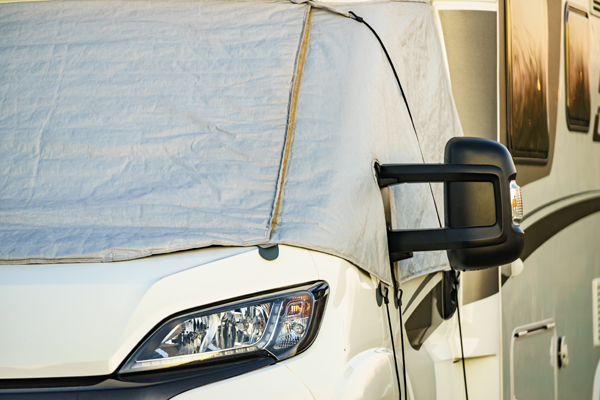Helpful Tips on Winterizing Your RV

Winter has arrived! By taking the time to properly gear up and prepare your recreational vehicle for the harsh winter conditions ahead, you could be saving thousands of dollars in money that would be spent on broken fittings, lining damages and other costly investments. Following this guide step by step will help ensure your RV is in prime condition when you hit the road for your next big adventure.
Drain the water from the plumbing system: This is the most important step to consider when winterizing your vehicle. Water left in the plumbing system of your RV can freeze and break valuable fixtures. This can be extremely costly to repair and can be avoided with minimal effort. To ensure this process is done correctly, you will need to pump nontoxic RV antifreeze throughout the water system, which will push any excess water or moisture out of the pipes.
Prepare the Exterior: To protect against the harsh elements of winter, we recommend investing in a cover specifically designed for your RV/Boat. Covers like these will protect against more than harsh weather conditions. They will also protect against UV rays, wind, dust, bird droppings, and other various elements that can damage the paint on your vessel. In addition to utilizing a cover, we also recommend taking measures to protect the tires of your RV, as not all covers designed to protect the RV will include tire protection. Another great way to ensure your tires maintain their tip top shape is to inflate them. It’s possible that they will lose pressure while being stored, so be sure to inflate them again before hitting the road.
Disconnect the batteries: To make sure your batteries aren’t damaged over winter, we recommend disconnecting them and storing them in a cool place. While your RV is in storage, it is likely that the charge in your batteries will slowly diminish. Storing these batteries in cooler temperatures will delay this process and save you time. To monitor the battery level and make sure it stays charged, check the voltage with a voltmeter or a multimeter every month or so.
Make it pest resistant: It’s not uncommon for mice and pests to end up making a home out of RVs during the winter and wreak havoc on the wiring, plastic components and other important items in your RV, so we recommend taking extra steps to ensure this doesn’t happen. Most importantly, make sure there is no food or remnants of food in the RV, and clean all the spaces where food has previously been (refrigerator, cupboards, countertops).
Add fuel stabilizer: When gas has been sitting for a long period of time, there is a high chance that oxidation will occur. This oxidation of gas can result in sticky deposits of resin that can easily damage the engine of your RV. By adding fuel stabilizer, you can prevent the formation of these gummy deposits. Following the instructions on the stabilizer, carefully add this to your fuel tank and fill the rest up with gas. To make sure the stabilizer gets absorbed through the entire fuel system, we recommend starting the engine and the generator and letting it run for 10 minutes or so.
Perform routine checks on your RV: If you can manage it, try to check up on your RV every few weeks for things like exterior cover damage, water damage, tire damage, or funky odors inside. Catching potential problems early on will stop them from getting worse and costing you in the spring.
We hope you have found value within this guide, and we’re confident that your RV will be better off surviving the winter having followed these tips. If you’re in need of a reliable place to store your RV, feel free to check out one of our locations near you.